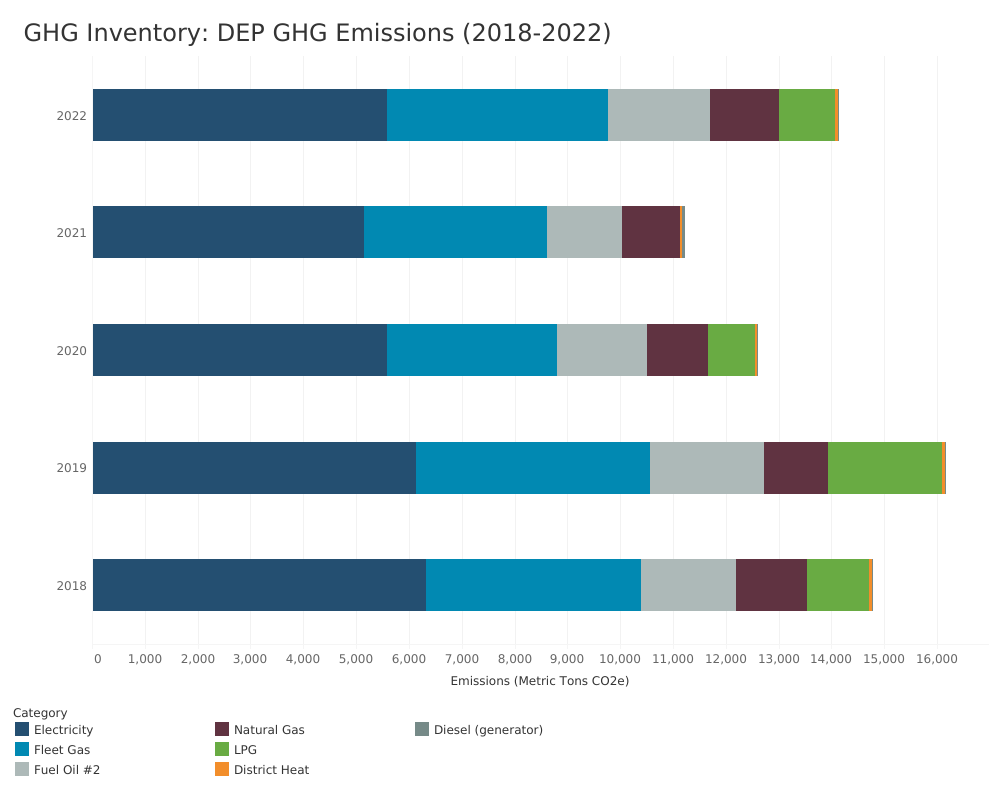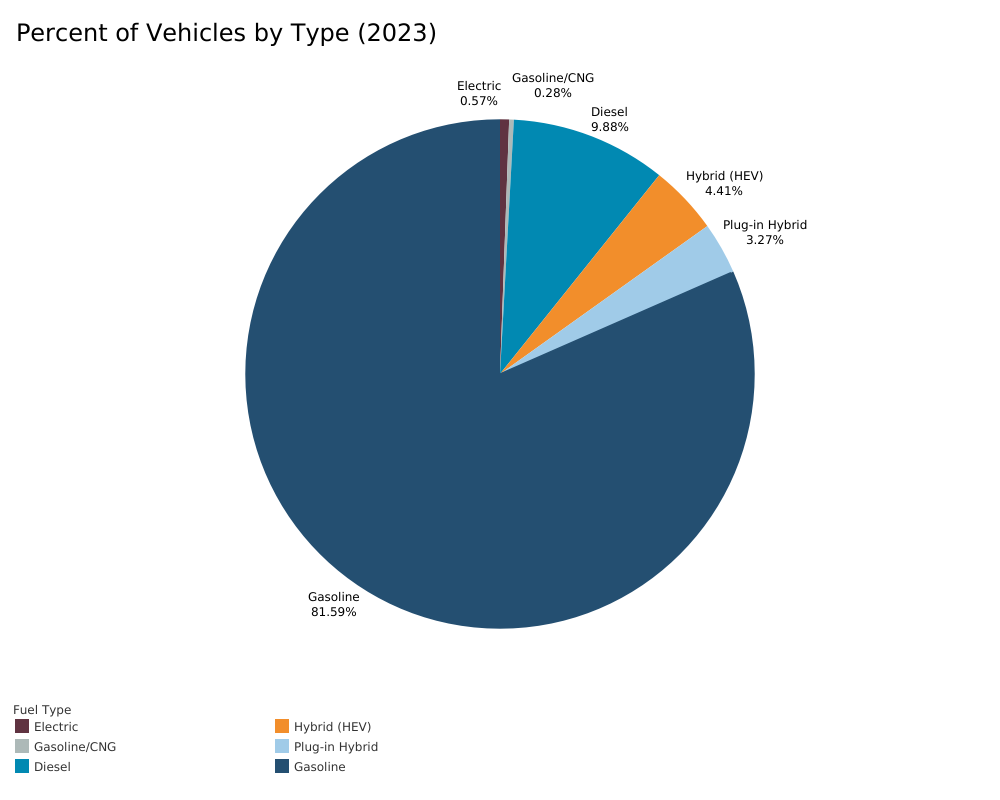
LEAD BY EXAMPLE
Lead by Example
The New Jersey Department of Environmental Protection (DEP) recognizes the critical leadership role it plays in combating climate change and advancing clean energy. Achieving the State’s ambitious greenhouse gas reduction goals requires a whole-of-government approach, including decarbonizing the operations of state government itself. With the Global Warming Response Act 80×50 report as the impetus, in July of 2023, Commissioner LaTourette issued Administrative Order 2023-13 , mandating the DEP to develop a “Lead by Example” Initiative. As mandated in the Administrative Order, the DEP shall inventory and analyze its owned and administered assets, develop policies and provide technical support concerning emissions reductions planning and projects, and assist in the deployment of clean energy systems across all assets. Through this initiative, DEP is committed to developing a greenhouse gas inventory for its operations, benchmarking energy and water usage at its facilities, identifying opportunities for energy efficiency and renewable energy solutions at its buildings and properties and developing a strategic energy plan. These activities will be a multi-year effort, requiring close coordination with multiple programs areas within the DEP. In October 2024 the DEP released its inaugural “Leading by Example Emissions Inventory Report” which identified trends and details of the DEP’s emissions reduction progress. The Emissions Inventory Report develops a baseline inventory of the Department’s buildings and vehicle stock, while also identifying opportunities to implement energy efficiency and climate mitigation projects.
Greenhouse Gas Inventory
Acknowledging that greenhouse gas inventories are critical tools in tracking progress in reducing greenhouse gas emissions, a DEP emissions inventory report is the first work product of this LBE initiative. The DEP’s inaugural “Leading By Example Emissions Inventory Report” evaluates both Scope 1 and Scope 2 emissions. The Report also identifies trends and details the Department’s emissions reduction progress to date.
Goals:
- 50% reduction by 2030 and 80% by 2050.
Background:
- Emissions generated by the Department from 2018-2022 for building and vehicle sectors were analyzed.
- The greatest source of emissions from the Department’s facilities is from the use of electricity.
- The DEP’s emissions in 2018 and 2019 hovered around 15,000 MT CO2e. This is equivalent to 195 tanker trucks’ worth of gasoline (or 34,150 barrels of oil).
- Department owned fossil-fuel vehicles make up second largest portion of overall emissions, at roughly 30%.
Progress to Date:
- In 2020 and 2021 CO2e emissions significantly decreased following the onset of the COVID-19 global pandemic.
- An overall decrease of 4% from 2018 electricity-based CO2 emissions.
Buildings
The DEP, as owners, operators, and tenants, of a unique and ample building inventory has an opportunity to achieve substantial reductions of building-related greenhouse gas emissions.
Goals:
- Perform energy audits at all DEP facilities and implement conservation measures to improve energy efficiency.
- Offset 100% of Department electricity usage with renewable energy.
- Phase out fossil fuel equipment at Department facilities.
Background:
- DEP has approximately 90 facilities across the state at which there are over 2,000 buildings and structures.
- Five facilities generated over 40% of the Department’s buildings-related emissions in 2022.
Progress to Date:
- Since 2019, 18 energy audits have been completed, with 9 implementing energy conservation measures and an additional 25 energy audits in progress.
- Six buildings are benchmarked via Energy Star Portfolio Manager, in compliance with the Clean Energy Act of 2018.
- DEP installed a 184 kilowatt (kW) solar photovoltaic (PV) array on the roof of its Headquarters at 401 East State Street in Trenton, New Jersey. The rooftop solar array was installed in 2012.
- The DEP is actively evaluating additional properties for potential solar installations.
Fleet
The DEP has a fleet of approximately 1,400 vehicles that are utilized by staff for activities such as site inspections, facility operations, and law enforcement. The DEP has opportunities to achieve substantial reductions of vehicle-related greenhouse gas emissions.
Goals:
- The State’s Electric Vehicle Law (P.L. 2019 c.362, 2020) establishes goals for state agency vehicle electrification: (1) by December 31, 2025, at least 25 percent of State-owned, non-emergency, light duty vehicles shall be plug-in electric vehicles; and (2) by December 31, 2035, 100 percent of State-owned, non-emergency, light duty vehicles shall be plug-in electric vehicles. In order to do this, the Department needs to electrify 123 vehicles by 2025 and an additional 367 by 2035, along with installing the associated charging infrastructure.
- Expand workplace charging infrastructure for employee commuting.
- Administrative Order 2021-05 requires DEP program areas in need of a vehicle to purchase the most fuel-efficient vehicle possible; and designates two DEP programs to collaborate on the review and approval of all DEP vehicle acquisitions and deployment of charging infrastructure. The AO establishes timelines for developing employee education materials to adapt to using DEP owned electric vehicles, and developing an implementation plan for deployment of electric vehicle charging infrastructure at DEP owned and managed facilities, for the public, and for DEP workplace locations for employees with personal electric vehicles.
Background:
- The Department has 1,400 vehicles, they are the second largest sources of greenhouse gas emissions.
Progress to Date:
- The Department has 75 vehicles (63 delivered, 12 pending delivery) that are Battery Electric Vehicles or Plug-in Hybrid.
- Since 2019 the Department has installed a total of 37 electric level 2 vehicle chargers and one direct current fast charger. There are EV chargers for staff and fleet use at locations in Trenton (401 Headquarters complex, the Document Control Center, and 225 East State Street), Ewing (Arctic Parkway Offices), and Jersey City (Liberty State Park).
Other Statewide Initiatives
DEP’s Lead By Example (LBE) efforts complement and are in conjunction with the LBE work being done across the State within other agencies. The Board of Public Utilities’ Division of State Energy Services (SES) provides statewide energy services to state agencies. The SES is responsible for the energy planning and procurement, energy capital planning and benchmarking of state buildings. Through the Energy Capital Committee, the SES and other members across the State utilize the State Facilities Initiative (SFI) which allows the State to lead by example by identifying and implementing energy efficiency projects and governmental and quasi-governmental mandated agencies and facilities. A designated project list for FY2024 can be found in the May 2024 State Facilities Initiative update . The DEP works with SES to increase the decarbonization work at its many facilities across the State.


